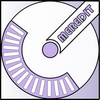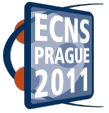NPL instruments at the research reactor LVR-15
The research reactor LVR-15 is a medium power light water research reactor operated by the Research Centre Řež. It is a medium power water reactor providing moderate flux of thermal neutrons at nine horizontal radial channes and vertical irradiation channels. NPL uses this facility as a source of neutrons for neutron scattering experiments and nuclear analytical methods. Five neutron scattering instruments are installed at four horizontal thermal neutron channels (HK4 HK6, HK8 and HK9) and serve primarily to resarch in the fields of material science and solid state physics. In addition, one horizontal channel (HK3) hosts special beamline for neutron depth profiling and prompt gamma activation analyses.
HK3 - Thermal neutron analytical methods
Three instruments HC3-a HC3-b and HC3-c operate at the thermal neutron beam formed by short neutron guide tube. The neutron guide ensures an efficient transport of thermal neutrons from a Ć 100 mm horizontal channel of the reactor to small target areas of the HC3-a, HC3-b and HC3-c spectrometers. The neutron guide is built of a mirror type tube of rectangular cross-section, cylindrically bent in the vertical direction. It consists of 15 mirror sections made of glass plates of float type. The surface of these plates is coated with Ni reflecting layer with thickness of 2000 Ă. The internal cross-section of each mirror section is 4×150 mm2. The overall length of the guide is 5.63 m, the curvature radius being 825 m. In order to suppress a background due to a direct beam of gamma rays and fast neutrons, the guide is tightly surrounded by a combined shielding consisting of lead and polyethylene pellets. Unlike thermal neutrons, gamma rays and fast neutrons are not subject to reflections from the Ni coating and penetrate the guide walls. In the shielding around they are scattered and absorbed and only collimated thermal neutrons pass through. In addition, a biological shielding, formed by boron-doped polyethylene and lead bricks, is built along the whole guide. The shape of the incoming neutron beam at the entrance of the guide matches the cross-section of the guide. This has been achieved using a 90 cm long collimator made of lead with a rectangular aperture. Immediately behind the guide exit, the neutron beam is tailored by an additional collimator made of 6Li2CO3 to reduce the beam cross-section to 4×60 mm2. The flux of thermal neutrons at the guide exit averaged over the beam cross-section is (1.5±0.2)·107n cm-2 s-1. The cadmium ratio is equal approximately to 105. The above mentioned fluxes refer to the reactor power of 8 MW. Beyond the guide exit, the vertical divergence of neutron trajectories is characterized by angular deviations below 0.5°.
Read more...
HK4 - Multipurpose Double Axis Diffractometer SPN-100
The two-axis diffractometer SPN-100 is equipped with bent Si and Ge perfect single crystal monochromators easily changeable according to the experimental requirements. The diffractometer is usually used for macro/micro strain scanning of polycrystalline materials. An easy change of the instrument parameters permits one to use it also for another type of experiments. The diffractometer uses advantages coming from focusing both in real and momentum space and yields good resolution and luminosity especially for samples of small dimensions. The resolution properties of the device arereached in a limited Q-range for which the focusing conditions are optimized. The corresponding optimization can be done easily by using a remote control of the curvature of the monochromator. Depending on the sample-detector distance and the required resolution the PSD detector can cover 7° (15°) of the scattering angle 2QS. In the case of the strain scanning of the sample, the gauge volume is determined by two fixed Cd slits (2-5)x(3-30) mm2 in the incident and diffracted beams and the measurements are performed in the vicinity of 2QS=90°. For scanning the sample a x-y-z stage can be used. The instrument is controlled by PC. Recently, the diffractometer has been equipped with a sandwich type monochromator consisting of two bent crystal slabs of different cuts providing two different neutron wavelengths simultaneously (Si(111) + Si(220), Si(220) + Ge(311)). This monochromator is mainly used for strain measurements when providing more sample reflections in the range of the investigated scattering angles.
Read more...
MEREDIT - Neutronový přáškový difraktometr
 Neutronový práškový difraktometr MEREDIT (MEdiumREsolution neutron powder DIffracTometer - neutronový práškový difraktometr se středním rozlišením) byl předán do provozu na konci roku 2008. Je umístěn na horizontálním kanálu číslo 6 v provozní hale výzkumného reaktoru LVR15 (lehko vodní reaktor) v Řeži u Prahy.
Neutronový práškový difraktometr MEREDIT (MEdiumREsolution neutron powder DIffracTometer - neutronový práškový difraktometr se středním rozlišením) byl předán do provozu na konci roku 2008. Je umístěn na horizontálním kanálu číslo 6 v provozní hale výzkumného reaktoru LVR15 (lehko vodní reaktor) v Řeži u Prahy.
Tento instrument je hlavně určen ke studiu krystalové a/nebo magnetické struktury práškových a polykrystakických vzorků. Díky několika rozšířením, mezi něž patří vakuová pec, kryostat, Eulerův goniometr, deformační troj, atd. ,je tento instrument univerzálním nástrojem pro výzkumníky, jež chtějí výužít výhod neutronové difrakce.
Read more...
HK8 - SANS and Neutron Optics Diffractometers
Neutron beam at the channel HK8 hosts two experimental facilities: High-resoiution SANS Diffractometer (MAUD) and Neutron Optics Diffractmeter (NOD). The two instruments use monochromatic beams selected by bent Si 111 and Si 220 monochromators situated in common shielding block. Such a construction is possible thanks to the very low absorption of silicon for thermal neutrons so that the first monochromator leaves the wavlength band for the second one almost intact. The common primary beam is shaped by a newly installed (in 2009) collimator with dimensions optimized for the beam size and divergence employed by the SANS instrument. It contains 10 cm thick sapphire filter and a sequence of B4C and Pb inserts in order to minimize gamma and neutron background and to suppress contamination of the beam by high-order Bragg reflections. The monochromators shielding is composed from inner Pb container and outer 40 cm thick wall made of concrete filled with B4C powder. The secondary collimators are equipped with horizontally and vertically adjustable slits, which permit fine tuning of required beam size delivered to the sample area.
Read more...
Difraktometr TKSN-400
Instrument TKSN 400 je dvojosý difraktometr s vysokým rozlišením, který je optimalizovaný pro studium vnitřních napětí v polykrystalických materiálech. Díky svému vybavení je určený především pro termomechanické testy materiálů, tj. pro studium deformačních a transformačních mechanismů nově vyvíjených moderních typů materiálů. Neutronová difrakce, prováděná in situ v průběhu externího namáhání, přináší celou řadu cenných strukturních a substrukturních informací o studovaném materiálu, tyto informace je možné korelovat s parametry vnějšího namáhání.
Read more...
Strana 1 z 2




